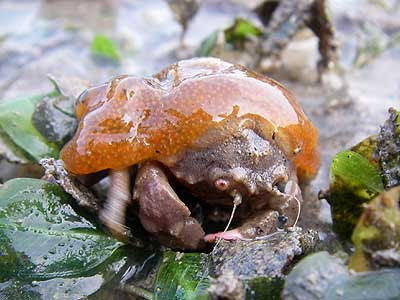
Found the above orange sea star among some seaweeds. It was really small, only about 3cm wide, and thus I really had a hard time trying to ID it, as it could be a juvenile with some of the distinguishing features not very clearly developed yet. After looking at the macro shots I have of both the top and under sides, I think it could be a juvenile cake sea star (Anthenea aspera), as I could roughly make out some bivalved pedicellariae on the under side. But then, it's so tiny, and thus I really can't say for sure.
For one thing, most of the IDs we have are based on species already found locally and published in books, so there are times when I wonder if we could be looking at a new species but tried to fit them into one of the known species.

JL found this little green sea star, which is about the same size as the orange star. I took some quick photos in a hurry, and forgot to take some close-ups for ID. So pai seh... But it was really hectic yesterday, as we only have about 1.5 hours of low tide to find thing and at the same time, had to do the filming.

The above is most probably a biscuit sea star (Goniodiscaster scabra).

This one is also probably a biscuit sea star, but some tiny spokes on the top surface makes me a little doubtful if it could be a Gymnanthenea laevis. Again, was rushing for time and thus couldn't take proper ID shots.
Actually, saw several small similarly-looking sea stars while we were doing the filming, but just couldn't spare time to take a closer look for the ID. Quite a pity actually.

There were lots of sand stars (Astropecten sp.), and some of them just suddenly appeared from the sand right next to me!

And here's a special find of the day - a 6-armed sea star (Luidia penangensis)! The only other time I've seen this was at Beting Bronok. And at that time, I din take any photos because it was also left with 2 or 3 complete arms, which I really regretted! So this time round, even though its also in a rather sorry state, I decided to take more photos of it.

Here's the under side. Like the 8-armed Luidia maculata, this sea star also has pointed tube feet which allow it to burrow quickly into the sand.

There were lots of brittle stars too.

In the 50m stretch of beach we explored, I only found one black sea urchin (Temnopleurus sp.).

But I was pleasantly surprised when JL showed me this - a heart urchin! This was the first time I saw a live heart urchin. Understand that they burrow under the sand most of the time, and thus it's quite uncommon to see them. We were really lucky, I must say!

And of course, at Changi we can always find a few types of sea cucumber. Have seem the above several times, but still not really sure what sea cucumber it is. Read some where that technically, all sea cucumbers can be eaten provided that they are treated properly to remove the toxin. But I guess luckily, many of the cute sea cucumbers on our shores are probably too small to be commercially viable.

Talking about small sea cucumbers, we found many of these pink thorny sea cucumbers (Colochirus quadrangularis) among the seaweed and seagrasses.
We also found several sand dollars, which I didn't take any pictures.
Here something that are not echinoderms though. This is the first some I saw so many of them exposed on the sand surface, and I felt I just have to blog about them.

They are the button shells (Umbonium vestiarum).

There must be like thousands and thousands of them, covering an area about 1m wide and 6 to 7m long, if not more! It was just amazing to see so many of them together.
Anyway, we managed to finish the main filming as the tide was rising.
All in all, it was a good trip with many interesting finds!











































